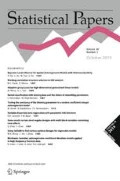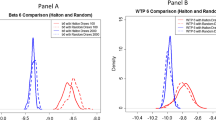Abstract
This paper compares the application of different versions of the simulated counterparts of the Wald test, the score test, and the likelihood ratio test in one- and multiperiod multinomial probit models. Monte Carlo experiments show that the use of the simple form of the simulated likelihood ratio test delivers relatively robust results regarding the testing of several multinomial probit model specifications. In contrast, the inclusion of the Hessian matrix of the simulated loglikelihood function into the simulated score test and (in the multiperiod multinomial probit model) particularly the inclusion of the quasi-maximum likelihood theory into the simulated likelihood ratio test leads to substantial computational problems. The combined application of the quasi-maximum likelihood theory with the simulated Wald test or the simulated score test is not systematically superior to the application of the other versions of these two simulated classical tests either. Neither an increase in the number of observations nor in the number of random draws in the incorporated Geweke-Hajivassiliou-Keane simulator systematically lead to more precise conformities between the frequencies of type I errors and the basic significance levels. An increase in the number of observations only decreases the frequencies of type II errors, particularly regarding the simulated classical testing of multiperiod multinomial probit model specifications.
Similar content being viewed by others
References
Börsch-Supan, A. and V.A. Hajivassiliou (1993), Smooth Unbiased Multi-variate Probability Simulators for Maximum Likelihood Estimation of Limited Dependent Variable Models, Journal of Econometrics 58, 347–368.
Börsch-Supan, A., V.A. Hajivassiliou, L.J. Kotlikoff, and J.N. Morris (1992), Health, Children, and Elderly Living Arrangements. A Multiperiod-Multinomial Probit Model with Unobserved Heterogeneity and Autocorrelated Errors, in: Wise D.A. (ed.), Topics in the Economics of Aging, Chicago, 79–104.
Bolduc, D. (1999), A Practical Technique to Estimate Multinomial Probit Models in Transportation, Transportation Research 33B (1), 63–79.
Bolduc, D., G. Lacroix, and C. Muller (1996), The Choice of Medical Providers in Rural Bénin: A Comparison of Discrete Choice Models, Journal of Health Economics 15, 477–498.
Brownstone, D. and K. Train (1999), Forecasting New Product Penetration with Flexible Substitution Patterns, Journal of Econometrics 89 (1–2), 109–129.
Czado, C. (2000), Multivariate Regression Analysis of Panel Data with Binary Outcomes Applied to Unemployment Data, Statistical Papers 41, 281–304.
Cramer, J.S. (1986), Econometric Applications of Maximum Likelihood Methods, Cambridge.
Garrido, R.A. and M. Leva (2004), Port of Destination and Carrier Selection for Fruit Exports: A Multi-Dimensional Space-Time Multi-Nomial Probit Model, Transportation Research 38B (7), 657–667.
Geweke, J., M. Keane, and D. Runkle (1994), Alternative Computational Approaches to Inference in the Multinomial Probit Model, The Review of Economics and Statistics LXXVI (4), 609–632.
Geweke, J., M. Keane, and D. Runkle (1997), Statistical Inference in the Multinomial Multiperiod Probit Model, Journal of Econometrics 80, 125–165.
Gouriéroux, C. and A. Monfort (1993), Simulation-Based Inference. A Survey with Special Reference to Panel Data Models, Journal of Econometrics 59, 5–33.
Hajivassiliou, V.A. and D. McFadden (1998), The Method of Simulated Scores for the Estimation of LDV Models, Econometrica 66 (4), 863–896.
Hajivassiliou, V. A., D. McFadden, and P. Ruud (1996), Simulation of Multivariate Normal Rectangle Probabilities and their Derivations. Theoretical and Computational Results, Journal of Econometrics 72, 85–134.
Inkmann, J. (2000), Misspecified Heteroscedasticity in the Panel Probit Model: A Small Sample Comparison of GMM and SML Estimators, Journal of Econometrics 97, 227–259.
Keane, M. (1994), A Computationally Practical Simulation Estimator for Panel Data, Econometrica 62 (1), 95–116.
Lee, L.-F. (1997), Simulated Maximum Likelihood Estimation of Dynamic Discrete Choice Statistical Models. Some Monte Carlo Results, Journal of Econometrics 82, 1–35.
Lee, L.-F. (1999), Statistical Inference with Simulated Likelihood Functions, Econometric Theory 15, 337–360.
Lerman, S.R. and C.F. Manski (1981), On the Use of Simulated Frequencies to Approximate Choice Probabilities, in: Manski C.F. and D. McFadden (eds.), Structural Analysis of Discrete Data with Econometric Applications, Cambridge/London, 305–319.
McFadden, D.L. (1973), Conditional Logit Analysis of Qualitative Choice Behavior, in: Zarembka P. (ed.), Frontiers in Econometrics, New York, 105–142.
McFadden, D.L. (1978), Modelling the Choice of Residential Location, in: Karlquist A. et al. (eds.), Spatial Interaction Theory and Planning Models, Amsterdam, 75–96.
McFadden, D.L. (1989), A Method of Simulated Moments for Estimation of Discrete Response Models without Numerical Integration, Econometrica 57 (5), 995–1026.
McFadden, D.L. and K. Train (2000), Mixed MNL Models for Discrete Response, Journal of Applied Econometrics 15 (5), 447–470.
Mühleisen, M. (1994), Human Capital Decay and Persistence. A Simulation Approach to German Unemployment, Frankfurt am Main.
Rendtel, U. and U. Kaltenborn (2004), The Stability of Simulation Based Estimation of the Multiperiod Multinomial Probit Model with Individual Specific Covariates, Diskussionsbeiträge des Fachbereichs Wirtschaftswissenschaft der FU Berlin (Volkswirtschaftliche Reihe) 2004/05, Berlin.
Rennings, K., A. Ziegler, and T. Zwick (2004), The Effect of Environmental Innovations on Employment Changes: An Econometric Analysis, Business Strategy and the Environment 13 (6), 374–387.
Revelt, D. and K. Train (1998), Mixed Logit with Repeated Choices: Households’ Choices of Appliance Efficiency Levels, The Review of Economics and Statistics LXXX (4), 647–657.
Ronning, G. (1991), Mikroökonometrie, Berlin.
Sándor, Z. and P. András (2004), Alternative Sampling Methods for Estimating Multivariate Normal Probabilities, Journal of Econometrics 120, 207–234.
Sándor, Z. and K. Train (2004), Quasi-Random Simulation of Discrete Choice Models, Transportation Research 38B (4), 313–327.
Stern, S. (2000), Simulation-Based Inference in Econometrics: Motivation and Methods, in: Mariano R. et al. (eds.), Simulation-Based Inference in Econometrics: Methods and Applications, Cambridge, 9–37.
Vijverberg, W.P.M. (1997), Monte Carlo Evaluation of Multivariate Normal Probabilities, Journal of Econometrics 76, 281–307.
White, H. (1982), Maximum Likelihood Estimation of Misspecified Models, Econometrica 50 (1), 1–25.
Wilde, J. (1999), Gemischte simultane Modelle für Querschnittsdaten, Frankfurt am Main.
Zhang, W. and L.-F. Lee (2004), Simulation Estimation of Dynamic Discrete Choice Panel Models with Accelerated Importance Samplers, Econometrics Journal 7, 120–142.
Ziegler, A. (2001), Simulated z-Tests in Multinomial Probit Models, Discussion Paper No. 01-53, Zentrum für Europäische Wirtschaftsforschung (ZEW), Mannheim.
Ziegler, A. (2005), A Comparison between Multinomial Logit and Probit Models, in: Scarpa, R. and A. Alberini (eds.), Applications of Simulation Methods in Environmental and Resource Econimics, Chapter 6, Springer Publisher, Dordrecht, The Netherlands, 97–116.
Ziegler, A. and A. Eymann (2001), Zur Simulated Maximum-Likelihood-Schätzung von Mehrperioden-Mehralternativen-Probitmodellen, Allgemeines Statistisches Archiv 85 (3), 319–342.
Author information
Authors and Affiliations
Rights and permissions
About this article
Cite this article
Ziegler, A. Simulated classical tests in multinomial probit models. Statistical Papers 48, 655–681 (2007). https://doi.org/10.1007/s00362-007-0362-3
Received:
Revised:
Issue Date:
DOI: https://doi.org/10.1007/s00362-007-0362-3




